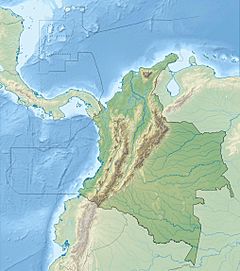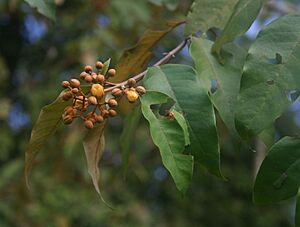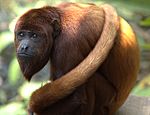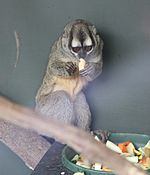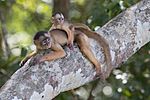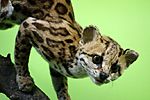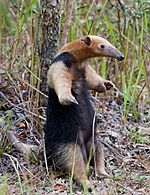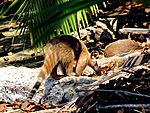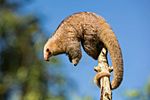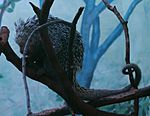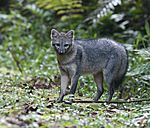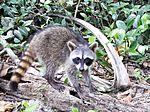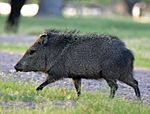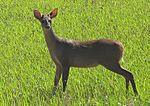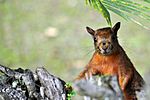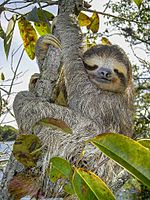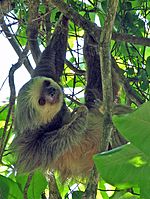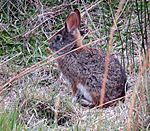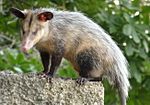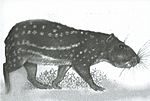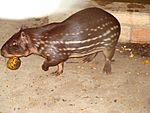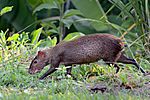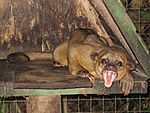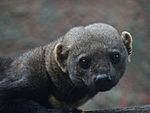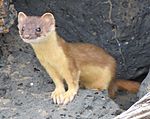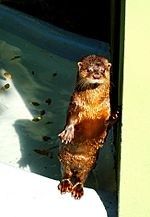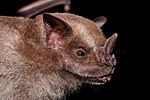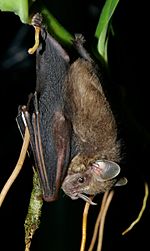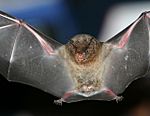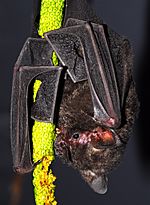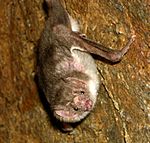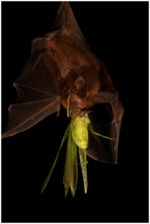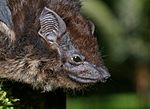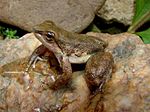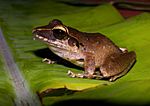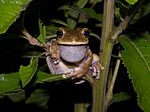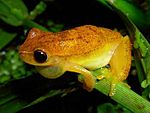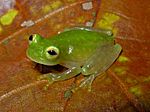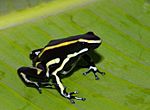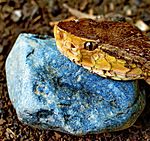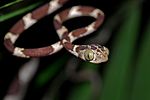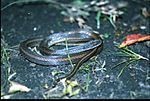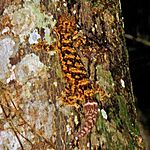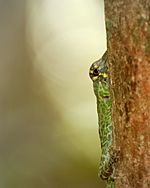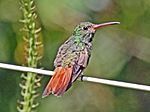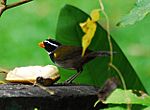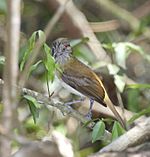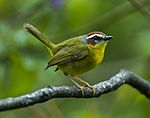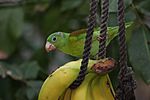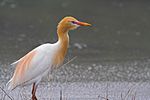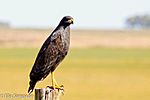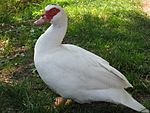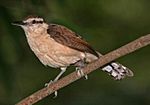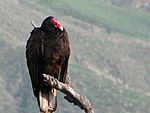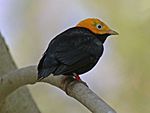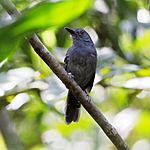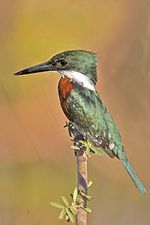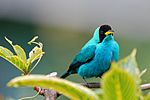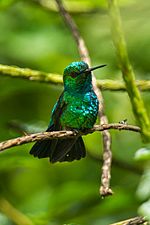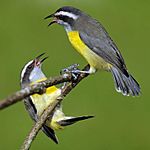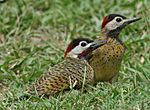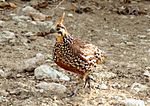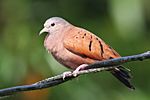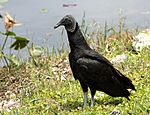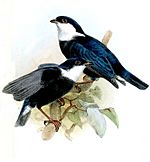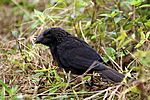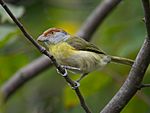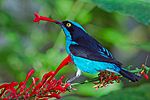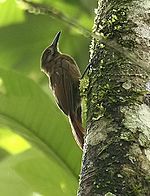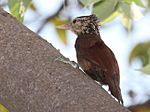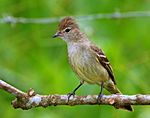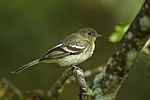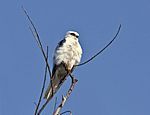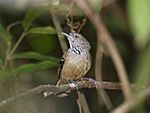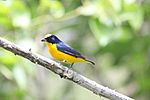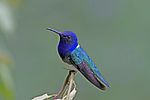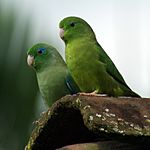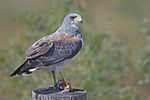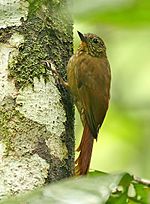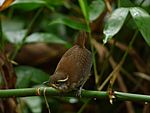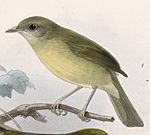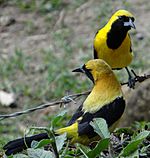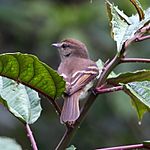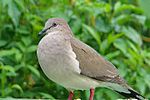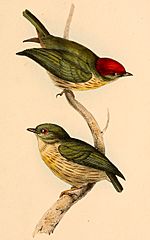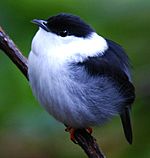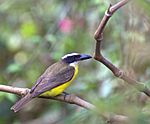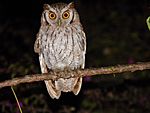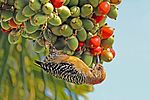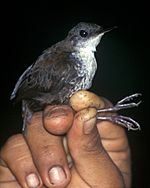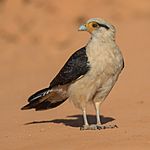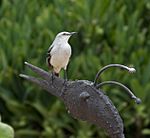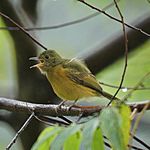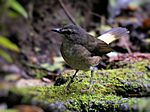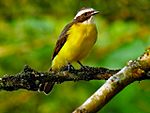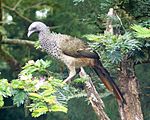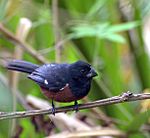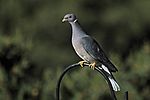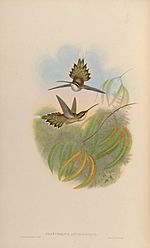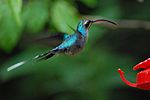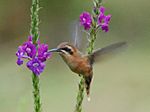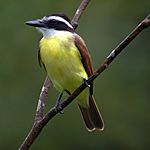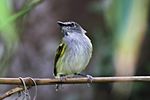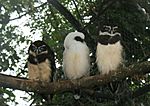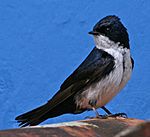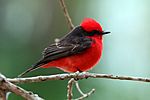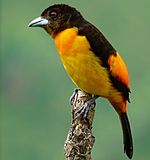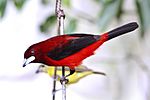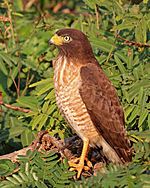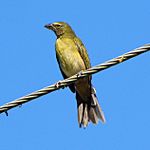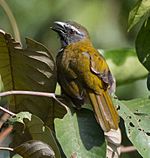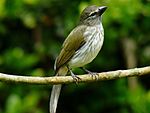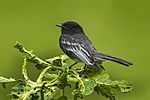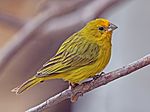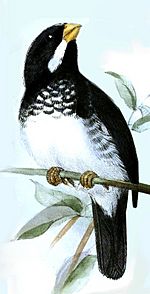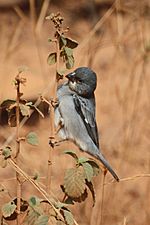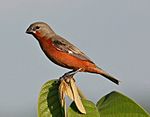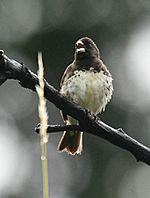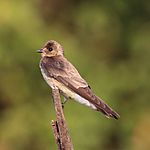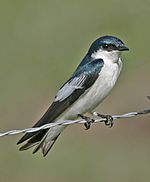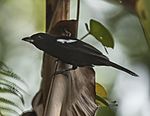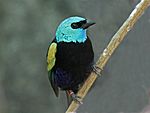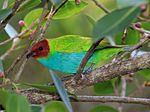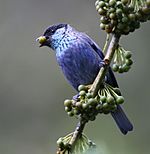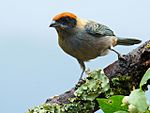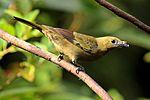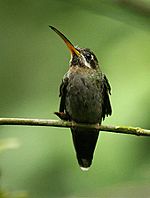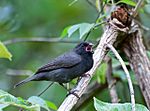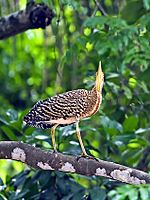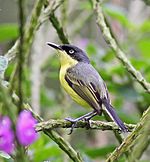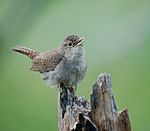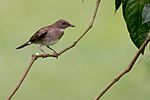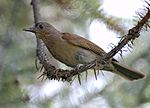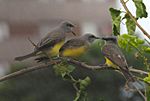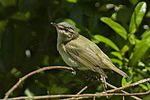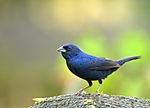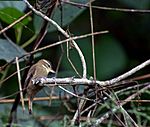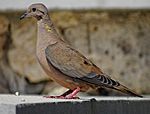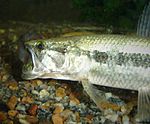Lebrija River facts for kids
Quick facts for kids Lebrija River |
|
|---|---|
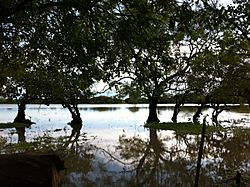
Barranca de Lebrija corregimiento on the banks of the Lebrija river (Municipality of Aguachica).
|
|
|
Location of the Lebrija River in Colombia
|
|
| Country | Colombia |
| Departments | |
| Provinces |
|
| Municipalities | |
| Physical characteristics | |
| Main source | Eastern Ranges Piedecuesta 2,532 m (8,307 ft) 7°05′59.1″N 73°00′55.1″W / 7.099750°N 73.015306°W |
| River mouth | Magdalena River Puerto Wilches / Loma de Corredor (Aguachica) 41.1 m (135 ft) 8°07′55.3″N 73°46′24.5″W / 8.132028°N 73.773472°W |
| Basin features | |
| River system | Magdalena Basin Caribbean Sea |
| Basin size | 8,790 km2 (3,390 sq mi) |
The Lebrija River is an important river in northern Colombia. It starts high up in the Eastern Andes Mountains in Piedecuesta. From there, it flows through the northern part of the Santander region. Finally, it joins the large Magdalena River near Puerto Wilches.
Contents
River's Name
The Lebrija River got its name from Antonio de Lebrija. He was a Spanish explorer who found the river in the year 1529.
River Journey
The Lebrija River begins very high up, at about 2,532 metres (8,307 ft) above sea level. Its starting point is in the Eastern Andes Mountains in the Santander region, northeast of Piedecuesta. The Lebrija River is actually formed by two other rivers joining together: the Suratá River and the Río de Oro.
As it flows north, the river passes through several towns. These include Girón, Bucaramanga (which is the capital of Santander), Lebrija, and Sabana de Torres. It eventually flows into the Magdalena River near Loma de Corredor in Puerto Wilches, Santander. At this point, the river is much lower, at about 41.1 metres (135 ft) above sea level.
Further down its path, the Lebrija River acts as a natural border. It separates the Santander region from the Cesar region. The river's entire basin, which is the area of land that drains into it, covers about 8,790 square kilometres (1.362×1013 sq in). About 100 kilometres (62 mi) of the river is wide and deep enough for boats to travel on.
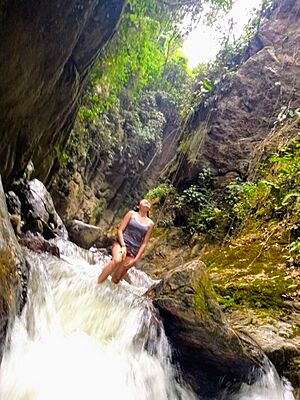
River Climate
The area around the Lebrija River, especially near Bucaramanga, gets a lot of rain. Sometimes, these heavy rains can cause problems, like harming fish in the river. The Lebrija River carries a huge amount of water each year, about 4.7 billion cubic meters!
The most water flows through the river in December. The least amount of water is in January. The upper part of the Lebrija River basin gets between 66 and 2065 millimeters of rain each year. There are two main rainy seasons: from March to May and from September to November. Drier times are from December to February and from June to August. Temperatures in the area can range from 0 to 35 degrees Celsius (32 to 95 degrees Fahrenheit).
Plants and Animals
The Lebrija River basin is home to many different kinds of plants and animals. Near Rionegro, people have found 761 different species. This includes 172 types of birds, 77 kinds of insects, 124 mammals, 104 fish, and 284 plant species. The Cerulean Warbler Bird Reserve, a special place for birds, is also close to the Lebrija River in Bucaramanga.
River Plants
In the upper parts of the Lebrija River, you can find many interesting plants. Some of these include Ocotea sp., Miconia sp., Guarea grandifolia, Hedyosmum bomplandianum, Vismia baccifera, and Cecropia sp..
River Animals
Mammals
Many mammals live in the upper and central parts of the Lebrija River basin. Here are some of them:
| Name | Species | Image |
|---|---|---|
| Venezuelan red howler | Alouatta seniculus | |
| gray-handed night monkey | Aotus griseimembra | |
| white-fronted capuchin | Cebus albifrons | |
| oncilla | Leopardus pardalis | |
| southern tamandua | Tamandua tetradactyla | |
| northern tamandua | Tamandua mexicana | |
| silky anteater | Cyclopes didactylus | |
| Brazilian porcupine | Coendou prehensilis | |
| crab-eating fox | Cerdocyon thous | |
| crab-eating raccoon | Procyon cancrivorus | |
| collared peccary | Pecari tajacu | |
| red brocket | Mazama americana | |
| red-tailed squirrel | Sciurus granatensis | |
| brown-throated sloth | Bradypus variegatus | |
| Linnaeus's two-toed sloth | Choloepus didactylus | |
| Hoffmann's two-toed sloth | Choloepus hoffmanni | |
| tapeti | Sylvilagus brasiliensis | |
| eastern cottontail | Sylvilagus floridanus | |
| common opossum | Didelphis marsupialis | |
| brown four-eyed opossum | Metachirus nudicaudatus | |
| mountain paca | Agouti paca | |
| lowland paca | Cuniculus paca | |
| black agouti | Dasyprocta fuliginosa | |
| Central American agouti | Dasyprocta punctata | |
| kinkajou | Potos flavus | |
| tayra | Eira barbara | |
| long-tailed weasel | Mustela frenata | |
| striped hog-nosed skunk | Conepatus semistriatus | |
| neotropical otter | Lontra longicaudis | |
| nine-banded armadillo | Dasypus novemcinctus | |
| Jamaican fruit bat | Artibeus jamaicensis | |
| pygmy fruit-eating bat | Artibeus phaeotis | |
| silky short-tailed bat | Carollia brevicauda | |
| Seba's short-tailed bat | Carollia perspicillata | |
| common vampire bat | Desmodus rotundus | |
| common big-eared bat | Micronycteris microtis | |
| Heller's broad-nosed bat | Platyrrhinus helleri | |
| greater sac-winged bat | Saccopteryx bilineata | |
| little yellow-shouldered bat | Sturnira lilium |
Amphibians and Reptiles
Here are some amphibians and reptiles found in the central Lebrija River basin:
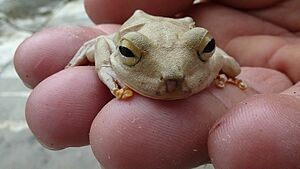
| Name | Species | Image |
|---|---|---|
| palm rocket frog | Rheobates palmatus | |
| robber frog | Craugastor raniformis | |
| emerald-eyed tree frog | Hypsiboas crepitans | |
| yellow treefrog | Dendropsophus microcephalus | |
| Fleischmann's glass frog | Hyalinobatrachium fleischmanni | |
| yellow-striped poison frog | Dendrobates truncatus | |
| South American common toad | Rhinella margaritifera | |
| fer-de-lance | Bothrops asper | |
| blunthead tree snake | Imantodes cenchoa | |
| red-nape snake | Ninia atrata | |
| yellow-bellied snake | Coniophanes fissidens | |
| turnip-tailed gecko | Thecadactylus rapicauda | |
| Polychrus marmoratus | ||
| Anolis frenatus |
Birds
Many bird species have been seen in the central Lebrija River basin. Here are some examples:
| Name | Species | Image |
|---|---|---|
| rufous-tailed hummingbird | Amazilia tzacatl | |
| orange-billed sparrow | Arremon aurantiirostris | |
| bright-rumped attila | Attila spadiceus | |
| rufous-capped warbler | Basileuterus rufifrons | |
| orange-chinned parakeet | Brotogeris jugularis | |
| cattle egret | Bubulcus ibis | |
| great black hawk | Buteogallus urubitinga | |
| Muscovy duck | Cairina moschata | |
| bicolored wren | Campylorhynchus griseus | |
| turkey vulture | Cathartes aura | |
| grey-cheeked thrush | Catharus minimus | |
| golden-headed manakin | Ceratopipra erythrocephala | |
| dusky antbird | Cercomacra tyrannina | |
| green kingfisher | Chloroceryle americana | |
| green honeycreeper | Chlorophanes spiza | |
| blue-tailed emerald | Chlorostilbon mellisugus | |
| bananaquit | Coereba flaveola | |
| spot-breasted woodpecker | Colaptes punctigula | |
| crested bobwhite | Colinus cristatus | |
| ruddy ground dove | Columbina talpacoti | |
| black vulture | Coragyps atratus | |
| white-bibbed manakin | Corapipo leucorrhoa | |
| smooth-billed ani | Crotophaga ani | |
| little tinamou | Crypturellus soui | |
| green jay | Cyanocorax yncas | |
| rufous-browed peppershrike | Cyclarhis gujanensis | |
| black-faced dacnis | Dacnis lineata | |
| violet-bellied hummingbird | Damophila julie | |
| plain-brown woodcreeper | Dendrocincla fuliginosa | |
| straight-billed woodcreeper | Dendroplex picus | |
| yellow-bellied elaenia | Elaenia flavogaster | |
| mountain elaenia | Elaenia frantzii | |
| white-tailed kite | Elanus leucurus | |
| checker-throated stipplethroat | Epinecrophylla fulviventris | |
| thick-billed euphonia | Euphonia laniirostris | |
| white-necked jacobin | Florisuga mellivora | |
| spectacled parrotlet | Forpus conspicillatus | |
| white-tailed hawk | Geranoaetus albicaudatus | |
| wedge-billed woodcreeper | Glyphorynchus spirurus | |
| white-breasted wood wren | Henicorhina leucosticta | |
| scrub greenlet | Hylophilus flavipes | |
| yellow-backed oriole | Icterus chrysater | |
| Euler's flycatcher | Lathrotriccus euleri | |
| white-tipped dove | Leptotila verreauxi | |
| striped manakin | Machaeropterus regulus | |
| white-bearded manakin | Manacus manacus | |
| boat-billed flycatcher | Megarhynchus pitangua | |
| tropical screech owl | Megascops choliba | |
| red-crowned woodpecker | Melanerpes rubricapillus | |
| southern nightingale-wren | Microcerculus marginatus | |
| yellow-headed caracara | Milvago chimachima | |
| tropical mockingbird | Mimus gilvus | |
| ochre-bellied flycatcher | Mionectes oleagineus | |
| buff-rumped warbler | Myiothlypis fulvicauda | |
| rusty-margined flycatcher | Myiozetetes cayanensis | |
| pauraque | Nyctidromus albicollis | |
| Colombian chachalaca | Ortalis columbiana | |
| chestnut-bellied seed finch | Oryzoborus angolensis | |
| band-tailed pigeon | Patagioenas fasciata | |
| pale-bellied hermit | Phaethornis anthophilus | |
| green hermit | Phaethornis guy | |
| stripe-throated hermit | Phaethornis striigularis | |
| olivaceous piculet | Picumnus olivaceus | |
| great kiskadee | Pitangus sulphuratus | |
| slaty-headed tody-flycatcher | Poecilotriccus sylvia | |
| spectacled owl | Pulsatrix perspicillata | |
| blue-and-white swallow | Pygochelidon cyanoleuca | |
| vermilion flycatcher | Pyrocephalus rubinus | |
| flame-rumped tanager | Ramphocelus flammigerus | |
| crimson-backed tanager | Ramphocelus dimidiatus | |
| roadside hawk | Rupornis magnirostris | |
| olive-grey saltator | Saltator olivascens | |
| buff-throated saltator | Saltator maximus | |
| streaked saltator | Saltator striatipectus | |
| black phoebe | Sayornis nigricans | |
| saffron finch | Sicalis flaveola | |
| Lesson's seedeater | Sporophila bouvronides | |
| plumbeous seedeater | Sporophila plumbea | |
| ruddy-breasted seedeater | Sporophila minuta | |
| yellow-bellied seedeater | Sporophila nigricollis | |
| southern rough-winged swallow | Stelgidopteryx ruficollis | |
| chestnut-collared swift | Streptoprocne rutila | |
| white-winged swallow | Tachycineta albiventer | |
| white-shouldered tanager | Tachyphonus luctuosus | |
| blue-necked tanager | Tangara cyanicollis | |
| bay-headed tanager | Tangara gyrola | |
| black-capped tanager | Tangara heinei | |
| scrub tanager | Tangara vitriolina | |
| barred antshrike | Thamnophilus doliatus | |
| blue-grey tanager | Thraupis episcopus | |
| palm tanager | Thraupis palmarum | |
| band-tailed barbthroat | Threnetes ruckeri | |
| sooty grassquit | Tiaris fuliginosus | |
| fasciated tiger heron | Tigrisoma fasciatum | |
| common tody-flycatcher | Todirostrum cinereum | |
| house wren | Troglodytes aedon | |
| black-billed thrush | Turdus ignobilis | |
| pale-breasted thrush | Turdus leucomelas | |
| tropical kingbird | Tyrannus melancholicus | |
| red-eyed vireo | Vireo olivaceus | |
| blue-black grassquit | Volatinia jacarina | |
| plain xenops | Xenops minutus | |
| eared dove | Zenaida auriculata |
Fish
Here are some fish species that have been found in the central Lebrija River basin:
| Name | Species | Image |
|---|---|---|
| guppy | Poecilia reticulata | |
| redhump eartheater | Geophagus steindachneri | |
| wolf fish | Hoplias malabaricus | |
| Prochilodus magdalenae | ||
| Sturisomatichthys leightoni |
Fun Fact
- In 1898, a princess named Theresa of Bavaria found the first recorded egg of the Magdalena River turtle (Podocnemis lewyana) near the Lebrija River.
See also
 In Spanish: Río Lebrija para niños
In Spanish: Río Lebrija para niños


